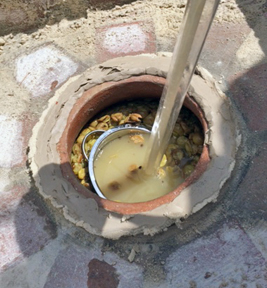On Sunday we opened the qvevri. I sealed the top of the qvevri last October 31st. The wine had been in the qvevri for 5 ½ months. I expected to see the clear wine at the top while the lees, seeds and skins in layers at the bottom. This is not what happened.
After moving three cubic feet of sand off the qvevri, we removed the top. Grape skins were at the surface. They did not fall to the bottom of the qvevri. Furthermore the wine was very cloudy, not clear. I racked the wine into a three gallon carboy. Two days later, the wine is clearing as particles are falling to the bottom. Why didn’t this happen in the qvevri. I have my theories.
One thought is that the egg-shape of the qvevri caused the wine to be in constant motion. If you took a spoonful of dirt and added it to a glass of water and gently stirred it, particles of the dirt would disperse through the water. As long as there was motion there would not be much settlement. Stop the stirring and the particles will fall to the bottom. This seems to be what is happening in my qvevri. While in the qvevri, the motion kept things stirred up. Now that the wine is in a carboy, particles are beginning to fall to the bottom.
Another thought is that my qvevri is only 23 liters, not several hundred or even one to three thousand liters in size. I have had many winemakers tell me over the past several years that making wine in small vessels is much more difficult than making it in larger vessels. I do not know if the mass of skins was heavy enough to fall to the bottom. Iago Bitarishvili, winemaker at Iago’s Wine in Chardakhi, Kartli, Georgia, concurred with the difficulty of making wine in small vessels. Because of the size of the vessel, there is a tendency not to add stems. Stems help with the filtering of the wine, but they take up space. I did not add stems to the qvevri back in October. This autumn, I will sacrifice wine and add some stems.
In a take on “misery enjoys company,” Giorgi Barisashvili of George Barisashvili Wine Cellar in Mtskheta, Kartli, Georgia commented that the grape skins remained at the top of the qvevri. This happened to him and some other Georgian winemakers this year. He has a theory that bacteria was causing a fermentation. With the weather finally warming, it is possible that malolactic fermentation took place and helped keep the skins at the top.
Kathy and I did taste the wine. My initial reaction was that the wine was floral and had a yeasty taste. The wine was made from Muscat grapes. The muscat grape profile kicked in on the aftertaste and remained for several minutes.
I will continue to research what happened. In the meantime, I will add steps to the winemaking protocol. I plan to leave the wine in a carboy until it clears up quite a bit. It has been getting clearer each day. Than I’ll rack to a clean carboy and filter before bottling. I should end up with 12 to 15 bottles. I already have additional thoughts about what I hope to do differently this year. I would like to make the wine in the qvevri in September rather than October. I will also add some stems and may do a better job of crushing the grapes before adding to the qvevri.
Terry




It maybe that the wine was undergoing a wild malolactic fermentation , there is a greater risk of this because skins can carry a lot of native fauna .
If that happened , there would have been gentle bubbling as co2 was released keeping things in suspension .
Worth a chromatography test to find out.